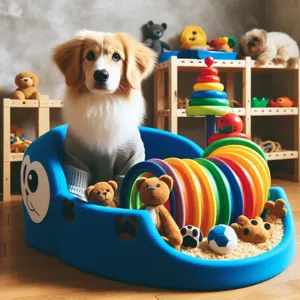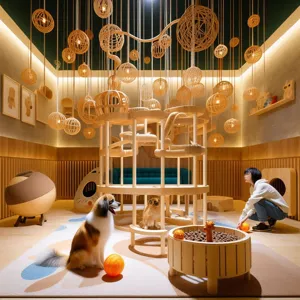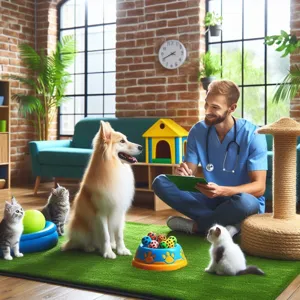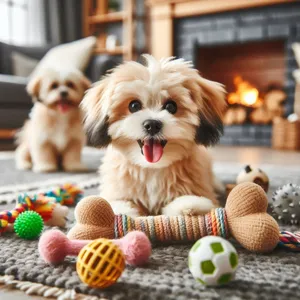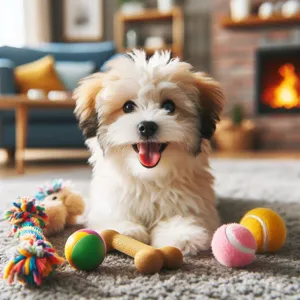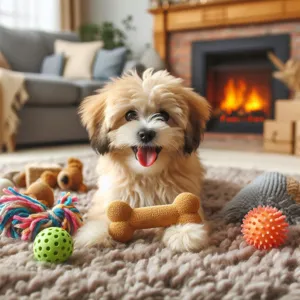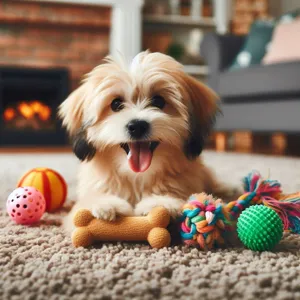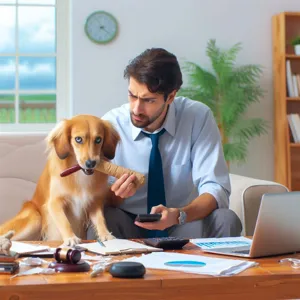Cats are known for their playful and curious nature, but keeping them entertained can sometimes feel like a challenge.
With their boundless energy and innate hunting instincts, providing the right toys is essential for ensuring that your feline friend remains both mentally stimulated and physically active. In this blog post, we’ll explore the top 10 must-have toys that will not only captivate your cat’s attention but also promote healthy playtime. From interactive puzzle toys that challenge their intellect to feather wands that ignite their predatory instincts, these selections are designed to cater to every kitty’s unique personality and preferences. Join us as we delve into the delightful world of cat toys, discovering how the right playthings can transform your home into a joyous playground, keeping your furry companion entertained and happy for hours on end!
1. Introduction: The Importance of Play for Cats
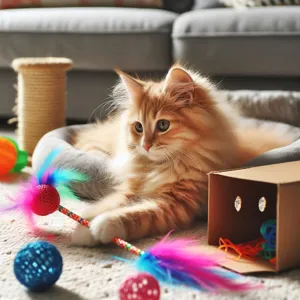
Cats are fascinating creatures, known for their playful antics and curious nature. While they may often seem independent and aloof, playtime is an essential part of a cat’s life that contributes significantly to their overall well-being. Engaging in regular play not only stimulates their minds but also provides crucial physical exercise, helping to keep them healthy and fit.
For cats, play mimics the hunting behaviors they would naturally exhibit in the wild. Pouncing on a feather toy or chasing a laser pointer allows them to unleash their inner predator, honing their reflexes and agility. Moreover, interactive play can help alleviate stress and anxiety, offering an outlet for their energy and curiosity. A bored cat can quickly become a destructive one, so providing them with fun and stimulating toys is vital in preventing unwanted behaviors.
Additionally, playtime can strengthen the bond between you and your furry friend. Engaging in play together fosters trust and companionship, making your cat feel loved and secure in their environment. Whether you have a playful kitten or a laid-back adult cat, there are countless toys designed to cater to their unique preferences and needs. In the following sections, we’ll explore the top 10 must-have toys that will not only keep your cat entertained but also contribute to a happy and fulfilling life.
2. Understanding Your Cat’s Play Behavior
Understanding your cat’s play behavior is essential for choosing the right toys to keep them entertained and engaged. Cats, by nature, are playful creatures, but their preferences can vary widely depending on factors such as age, personality, and breed. Observing your feline friend in action can provide valuable insights into what stimulates their curiosity and ignites their hunting instincts.
For instance, younger cats and kittens are often more energetic and may prefer toys that allow them to pounce, chase, and explore. They thrive on interactive play, so look for feather wands or laser pointers that mimic the movements of prey. On the other hand, older cats might favor gentler stimulation. They may enjoy toys that they can bat around or cuddle with, such as plush mice or crinkly balls that make enticing sounds without requiring too much exertion.
Additionally, some cats are solitary players, while others enjoy social interaction during playtime. If your cat tends to be more independent, consider puzzle toys that challenge their problem-solving skills with hidden treats. For social butterflies, interactive toys that require human involvement can strengthen your bond and provide the stimulation they crave.
Understanding these behaviors not only helps you select the perfect toys but also ensures that your cat remains mentally and physically active. By catering to their individual play styles, you can create an enriching environment that keeps their natural instincts alive and fosters a happy, healthy lifestyle. So, take the time to observe and engage with your cat—this will guide you in making the best toy choices for their unique personality!
3. Interactive Toys: Engaging Your Cat’s Hunting Instincts
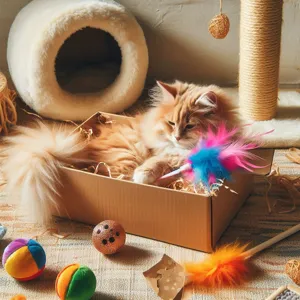
Interactive toys are a fantastic way to tap into your cat’s natural hunting instincts, providing both mental stimulation and physical exercise. These toys are designed to mimic the movements and sounds of prey, sparking your feline’s curiosity and encouraging them to engage in play that mimics real-life hunting scenarios.
Imagine your cat pouncing and stalking after a feather teaser or a motorized mouse that scurries unpredictably across the floor. Such toys not only help satisfy their predatory urges but also keep them entertained for hours on end. Many interactive toys come equipped with features like motion sensors or remote controls, allowing you to initiate play while you sit back and enjoy the show.
Puzzle toys are another excellent option within this category, challenging your cat to figure out how to access treats hidden inside. These toys engage their minds as they work through the problem, providing a rewarding experience when they finally uncover the hidden prize.
Not only do interactive toys promote physical activity, but they also help reduce boredom and anxiety, which can lead to destructive behaviors. By providing your cat with a variety of stimulating interactive toys, you’ll create an enriching environment that keeps them happy, healthy, and mentally sharp. After all, a well-stimulated cat is a content cat, ready to conquer their next playtime adventure!
4. Wand Toys: The Joy of Active Playtime
Wand toys are a timeless favorite among cat enthusiasts, and for good reason. These delightful playthings combine a simple design with the allure of movement, sparking your cat’s instinctual hunting behaviors. At the end of a long stick or wand, you’ll typically find a feather, a dangling plush, or even a series of colorful ribbons that dance and flutter in the air. This dynamic movement mimics the erratic flight of birds or the scurrying of small prey, captivating your feline friend’s attention and igniting their natural curiosity.
Engaging your cat with a wand toy creates an interactive playtime experience that not only entertains but also promotes physical exercise. As your cat leaps, pounces, and swats at the enticing lure, they’re getting a workout that helps maintain a healthy weight and strong muscles. Plus, the bonding experience created through active play can enhance your relationship with your furry companion, as they see you as an integral part of their fun.
To make the most of your wand toy sessions, vary your movements—spin, flick, or drag the toy across the ground to keep your cat guessing. You can even incorporate short breaks to mimic the unpredictability of prey, allowing your cat to stalk and pounce with increased excitement. Remember to let them catch the toy occasionally; the thrill of victory is just as crucial as the chase itself. Wand toys are not only a source of joy for your cat but also a wonderful way for you to engage in their playful world. With a bit of creativity and enthusiasm, these simple toys can bring hours of happiness to both you and your feline friend!
5. Puzzle Feeders: Stimulating Your Cat’s Mind
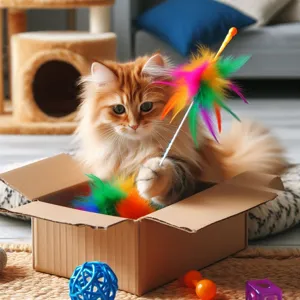
Puzzle feeders are an exceptional way to engage your feline friend’s intellect while also satisfying their natural instincts to hunt and forage. These cleverly designed toys challenge your cat to think critically and solve problems to access their favorite treats or kibble, turning mealtime into an exhilarating game.
Imagine your cat, tail twitching in excitement, as they nudge, paw, and roll a feeder to uncover hidden morsels. The act of working for their food not only keeps them physically active but also provides much-needed mental stimulation. This is particularly important for indoor cats, who may not have as many opportunities for natural exploration and play.
There are a variety of puzzle feeders on the market, ranging from simple designs with easy-access compartments to more complex models that require multiple steps to reveal the reward. Choose one that matches your cat’s skill level to keep them engaged without causing frustration.
Not only do puzzle feeders help curb boredom, but they can also aid in slowing down fast eaters, promoting healthier eating habits and reducing the risk of obesity. Plus, the time your cat spends figuring out how to get to their food is time well spent, ensuring they stay entertained and happy. Incorporating a puzzle feeder into your cat’s daily routine can turn a mundane meal into an adventure, making it a must-have addition to your pet care arsenal!
6. Catnip Toys: The Feline Favorites
Catnip toys are often regarded as the holy grail of feline entertainment, and for good reason! These delightful playthings are infused with catnip, a herb that produces a euphoric reaction in many cats. When your furry friend encounters a catnip toy, you may witness an enchanting transformation: purring, rolling, and playful antics that can leave you both amused and captivated.
The effects of catnip typically last about 10 to 15 minutes, after which your cat may lose interest for a while, only to return later for another bout of joyful madness. This cyclical excitement makes catnip toys perfect for providing bursts of energetic play throughout the day. They come in a variety of shapes and sizes, from stuffed mice to plush balls, allowing you to cater to your cat’s unique preferences.
Beyond sheer entertainment, catnip toys can also serve as great mental stimulation. As your cat engages with these toys, they not only fulfill their instinctual hunting behaviors but also provide a healthy outlet for pent-up energy. This can be particularly beneficial for indoor cats, helping to keep them agile and mentally sharp.
When choosing catnip toys, look for high-quality materials that can withstand the enthusiastic chewing and clawing of your feline companion. Many toys even come with replaceable catnip pouches, ensuring the fun never has to end. So, if you want to see your cat in a state of sheer bliss, investing in catnip toys is a must! They’ll not only keep your kitty entertained but also strengthen the bond you share through interactive play.
7. Ball Toys: Simple Fun for Cats of All Ages
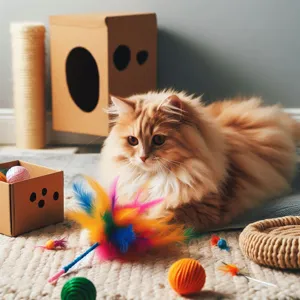
When it comes to feline entertainment, few toys can match the timeless appeal of ball toys. These simple yet engaging playthings provide an endless source of amusement for cats of all ages, from feisty kittens to wise old companions. The charm of ball toys lies in their versatility; they come in various sizes, colors, and materials, catering to the unique preferences of your furry friend.
A classic choice, the lightweight plastic ball can be batted around with ease, allowing your cat to engage its natural hunting instincts. Many ball toys even feature bells or crinkly textures that add an auditory element to playtime, enticing your cat to pounce and chase. For those looking to add a twist, consider balls that dispense treats or catnip, transforming a simple game of chase into a rewarding experience.
For senior cats or those with less energy, softer, plush balls can provide the same joy without requiring too much exertion. Watching a cat gently paw at a ball, nudging it across the floor, can be just as entertaining as watching them leap and bound in pursuit of a more challenging toy.
No matter the design, ball toys encourage physical activity, mental stimulation, and social interaction, whether your cat is playing solo or engaging with you in a game of fetch. They are an affordable and easy way to enrich your pet’s environment, ensuring that your home remains a sanctuary of play and exploration. With ball toys, you provide your feline friend with not just a toy, but an avenue for joy and exercise that keeps them happy and healthy.
8. Laser Pointers: The Ultimate Chase Experience
Laser pointers are a feline favorite, providing an exhilarating chase experience that taps into your cat’s natural hunting instincts. With just a flick of a finger, you can transform any ordinary space into an exciting arena where your cat can leap, pounce, and sprint after that elusive red dot. The unpredictability of the laser’s movement stimulates your cat’s mind, encouraging them to engage in vigorous play that mimics the thrill of stalking prey.
One of the best aspects of laser pointers is their ability to entertain cats of all ages. Kittens, with their boundless energy, will revel in the challenge of catching the moving light, while older cats can enjoy a low-impact workout that keeps them active without putting too much strain on their joints. Just be sure to keep play sessions relatively short to prevent frustration—after all, that red dot can be tantalizingly out of reach!
To maximize the fun, consider incorporating some interactive elements into your playtime. Move the laser pointer across the floor, darting it under furniture, or across walls to create a more dynamic chase. You can also alternate between the laser pointer and other toys to give your cat the satisfaction of catching something tangible.
However, it’s essential to remember that the joy of the chase can sometimes leave your cat feeling a bit unsatisfied if they never “catch” their target. To remedy this, end each play session by directing the laser pointer to a physical toy or treat, allowing your cat to make a successful capture. This simple trick ensures that your feline friend feels accomplished and satisfied after their energetic escapade, keeping them happy and eager for more playtime in the future.
With a laser pointer in your toy arsenal, you’re guaranteed to provide hours of entertainment and joy for your furry companion, making it a must-have item for any cat owner!
9. Scratching Posts: Dual Purpose for Play and Scratching
When it comes to cat toys, scratching posts are often overlooked, yet they are a must-have in every feline-friendly household. These versatile structures serve a dual purpose: they not only provide an essential outlet for your cat’s scratching instincts but also offer a fantastic playground for them to explore and enjoy.
Imagine a robust scratching post adorned with textured surfaces that invite your kitty to dig in those claws. The satisfying sound of their nails snagging against the fibers creates a delightful experience that helps to keep their claws healthy and trim. Scratch away, dear cat!
But the fun doesn’t stop there. Many scratching posts come with added features, such as dangling toys, platforms, or even tunnels, transforming them into a multi-functional playground. Your cat can leap, climb, and swat at their favorite toys, all while enjoying the benefits of a designated scratching area. This not only keeps them entertained but also encourages essential exercise, helping to maintain a healthy weight and promote overall well-being.
Incorporating a scratching post into your home also protects your furniture from those inevitable scratching sessions. By providing an appealing alternative, you can redirect their natural behaviors away from your beloved couch or curtains. Plus, many scratching posts come in stylish designs that can seamlessly blend into your home decor, so you won’t have to sacrifice aesthetics for functionality.
So, whether you opt for a tall, multi-level scratching tower or a simple, sturdy post, your cat will thank you for this essential addition to their playtime routine. Scratching posts are not just toys; they are vital tools for keeping your feline friend entertained, happy, and engaged.
10. Electronic Toys: High-Tech Fun for Your Feline
In the age of technology, why not let your cat enjoy some high-tech entertainment? Electronic toys are an exciting addition to your feline friend’s playtime repertoire, providing interactive experiences that can keep them engaged for hours on end. These toys come in various forms, from automated laser pointers to battery-operated mice that scurry across the floor, mimicking the movements of real prey.
Imagine your kitty’s delight as they pounce and chase after a small robotic mouse that darts unpredictably around the room, or how they’ll leap and swat at a laser light that dances tantalizingly on the wall. Many electronic toys are designed with built-in timers and random movement patterns, ensuring that your cat never knows where the next surprise will come from, stimulating their natural hunting instincts and keeping boredom at bay.
Moreover, some innovative electronic toys even incorporate features that cater to your cat’s intelligence, like puzzle feeders that dispense treats as they bat and nudge them. This not only encourages physical activity but also promotes mental stimulation, making playtime beneficial for both their body and mind.
When choosing electronic toys, look for ones that are durable and safe, with no small parts that could pose a choking hazard. With the right electronic plaything, you can transform your home into a playground of high-tech fun, ensuring your feline companion remains entertained, happy, and active!
11. DIY Toy Ideas: Creating Fun on a Budget
Creating toys for your feline friend doesn’t have to break the bank. In fact, some of the most engaging and entertaining toys can be crafted right at home with everyday materials. Embracing diy toy ideas not only saves you money but also allows you to tailor the toys to your cat’s unique preferences and play style.
**1. Crumpled Paper Balls:** One of the simplest and most effective toys is a crumpled ball of paper. Just take a sheet of paper, crumple it into a ball, and watch your cat go wild. The sound of the paper rustling and the unpredictability of the ball’s movements will engage their hunting instincts.
**2. Feather Wands:** If you have some old feathers lying around, you can easily create an enticing feather wand. Attach a few feathers to a sturdy stick or string, and dangle it in front of your cat. This interactive toy not only provides exercise but also strengthens the bond between you and your pet as you play together.
**3. Sock Mice:** Old socks can be transformed into delightful mouse toys. Fill a sock with catnip and some crumpled paper for added texture, then tie it off securely. Your cat will love pouncing on its new ‘prey’ and tossing it around the house.
**4. Cardboard Boxes:** Don’t underestimate the power of a simple cardboard box. Cats love to explore, hide, and play in boxes. Cut some holes in the sides for added fun and let your cat’s imagination run wild as they create their own little hideaway.
**5. Roll-Up Tunnels:** If you have some fabric or old t-shirts, you can create a fun tunnel for your cat to crawl through. Simply sew or tie the fabric into a tube shape, and watch your cat delight in dashing through their new play space.
These DIY toy ideas not only keep your cat entertained but also stimulate their natural instincts, encouraging them to play, pounce, and explore. Plus, every time you pull out a homemade toy, you can feel the satisfaction of having created something special just for your furry friend. Remember, the best part about these DIY projects is the joy they bring—not just to your cat, but to you as well!
12. Safety Considerations When Choosing Toys
When it comes to selecting toys for your feline friend, safety should always be your top priority. Cats are naturally curious creatures, and their playful antics can sometimes lead to unexpected accidents if the wrong toys are introduced into their environment. Here are some essential safety considerations to keep in mind while choosing toys for your cat.
First and foremost, inspect the materials used in the toys. Opt for those made from non-toxic substances, as cats often chew and bat at their toys. Avoid toys with small parts that can easily be swallowed or chewed off, as these pose a choking hazard or could lead to serious digestive issues. Look for durable toys that can withstand your cat’s playful claws and teeth; flimsy toys may break apart and create a potential danger.
Additionally, consider the size of the toy. It should be appropriately sized for your cat to carry, bat around, and chew without the risk of getting stuck in their throat. Toys that are too small can easily be swallowed, while oversized toys may not be engaging to your pet.
It’s also wise to avoid toys with strings, feathers, or bells that could become loose, as these can entangle or cause injury if ingested. Instead, look for securely attached components or those designed specifically for safe play.
Lastly, supervise your cat while they play, especially with new toys. This allows you to observe how they interact with their toys and intervene if any hazards arise. By prioritizing safety in your selection, you’ll ensure your cat can enjoy their playtime without any worries, leading to a happier and healthier feline companion.
13. Rotating Toys: Keeping Playtime Fresh
When it comes to keeping your feline friend engaged and happy, rotating toys can be a game-changer. Cats are naturally curious creatures, and their interest in toys can wane quickly if they are exposed to the same ones day after day. By introducing a rotation system, you can keep playtime fresh and exciting, ensuring that your cat remains mentally stimulated and physically active.
Start by curating a diverse collection of toys that cater to different play styles. Consider plush mice, feather wands, laser pointers, and interactive puzzles. The key is to select a variety that encourages different types of play—some toys for pouncing and stalking, others for batting and chasing. Once you have a robust inventory, create a schedule to rotate the toys every few days or weekly.
When it’s time to introduce a “new” toy, your cat will likely approach it with renewed curiosity, as if it’s a brand new discovery. This simple act can reignite their interest, turning an old favorite into a thrilling challenge once again. You might even notice them engaging with the toys in new ways, showcasing their playful instincts and keeping their minds sharp.
Additionally, rotating toys can help prevent boredom and reduce the likelihood of destructive behavior, which is common when cats feel under-stimulated. By keeping things dynamic and fun, you’re providing your cat with a rich environment that promotes their overall well-being. So, embrace the art of rotation and watch as your cat’s excitement for playtime flourishes!
14. Conclusion: Finding the Right Toys for Your Cat
When it comes to keeping your feline friend entertained and happy, choosing the right toys is essential. Cats are playful creatures by nature, and engaging them with the right stimulation can significantly enhance their physical and mental well-being. In this journey to find the perfect toys for your cat, consider their unique personality, age, and energy level.
Some cats may thrive on interactive toys that challenge their hunting instincts, while others might prefer the comfort of a cozy plush toy to snuggle with during quiet moments. Remember, variety is key; rotating toys can keep their interest piqued and prevent boredom.
Don’t forget to observe your cat’s preferences. Do they love chasing after feather wands, or do they prefer to pounce on laser pointers? Every cat is an individual, and discovering what sparks joy for your furry companion can lead to countless hours of fun.
Additionally, ensure that the toys you choose are safe and durable, as cats can be quite mischievous and prone to chewing or tearing their toys apart. Investing in high-quality toys not only enhances their playtime but also ensures their safety.
Ultimately, the right toys can strengthen the bond you share with your cat, as you engage in playful activities together. So, take the time to explore various options, and watch your beloved pet’s happiness soar as they dive into a world of fun and adventure!
15. Call to Action: Share Your Cat’s Favorite Toys!
We want to hear from you! As a community of passionate cat lovers, your insights and experiences are invaluable. What toys have your feline friends absolutely adored? Whether it’s a feathered wand that sends them leaping through the air, a puzzling interactive toy that keeps their minds sharp, or that simple cardboard box that sparks their imagination, we want to know!
Share your cat’s favorite toys in the comments below and help fellow cat owners discover new ways to keep their furry companions entertained and happy. Your contributions could spark joy for countless cats and their humans, creating a lively exchange of ideas and recommendations. Plus, don’t forget to include pictures—because what’s a cat toy discussion without adorable snapshots of our playful pals? Let’s celebrate our beloved cats and ensure they have the happiest, most engaging playtime possible!
In conclusion, keeping your feline friend entertained and happy is essential for their well-being, and the right toys can make all the difference. From interactive wand toys that stimulate their hunting instincts to cozy hideaways that offer a sense of security, each of the top 10 must-have toys we’ve discussed can enhance your cat’s playtime and enrich their daily life. Remember, every cat has its unique personality and preferences, so don’t hesitate to experiment with different types of toys to discover what captivates your furry companion the most. By investing in quality playtime, you’re not only fostering a happier and healthier cat but also strengthening the bond you share. Happy playing, and may your home be filled with joyful purrs and playful antics!

